15 Fall Flowers That Will Keep Your Garden Blooming All Season Long
These autumn flowers will add late-season color to your yard or container garden, even while the weather cools.

Photos by R A Kearton / GETTY IMAGES
Though the summer is winding down, the fall season can still provide some spectacular opportunities for your garden. Celebrate autumn’s cooler days and provide food for pollinators by adding fall-blooming plants to your landscape. Birds, bees, and butterflies preparing to migrate, hibernate, or just hunker down for winter will feast on your fall flowers, and you’ll love your gardens’ colors and fragrance on some of nicest days of the year.
Thinking about adding some autumn flowers to your garden this season? We talked with horticulturists in two parts of the country to learn which garden plants bring the best fall blooms.
Meet Our Expert
Nicole Sanchez, Associate Professor of Horticulture at Oregon State University Extension Service
Shannon Currey, horticulturist with Izel Native Plants
Related: 15 Plants That Fill Your Yard With Fall Color
Bee Balm (Purple Rooster)
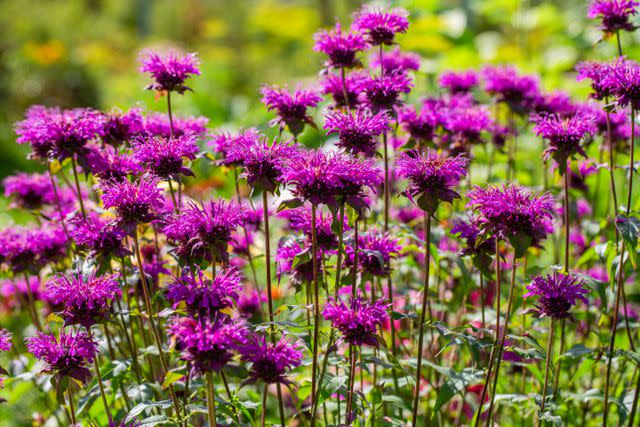
Olga Seifutdinova / GETTY IMAGES
Producing big, 3-inch-diameter flower clusters, Monarda didyma Purple Rooster keeps the color coming in your fall garden. Hardy and adaptable, it’s also among the Bee Balms that are resistant to powdery mildew, says Nicole Sanchez, associate professor of Horticulture at Oregon State University Extension Service. Bees, butterflies, and hummingbirds love it.
Zones: 4 to 9
Planting time: Plant container-grown plants in spring after chance of frost has passed or in fall. Plant seeds indoors about eight weeks before the last frost or sow directly in your garden when the weather is reliably warm.
Size: 3 to 4 feet tall x 2 feet wide
Growing conditions: Full sun to partial shade; almost any evenly moist, well-draining soil
Black-Eyed Susan (American Gold Rush)

Sharon Talson / GETTY IMAGES
A 2020 All-America Selections winner and the Perennial Plant Association’s 2023 Perennial Plant of the Year, American Gold Rush is one of the more compact cultivars in the Rudbeckia genus and bursts with stunning yellow-gold fall blooms. Pollinator-friendly, it keeps on blooming until frost and resists Septoria leaf spot, which causes some of the other black-eyed Susans to decline earlier in the season.
Zones: 4 to 9
Planting time: Plant container-grown plants in spring after chance of frost has passed or in fall. Plant seeds indoors 6 to 10 weeks before your average last frost, keeping containers in a cool place for 4 weeks after planting.
Size: 22 to 27 inches tall x up to 40 inches wide
Growing conditions: Full sun to partial shade; average, well-draining soil
Blue Mistflower
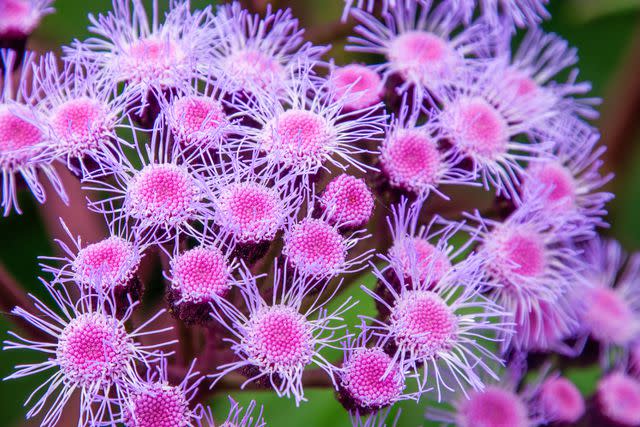
Karin de Mamiel / GETTY IMAGES
Native Conoclinium coelestinum blooms from late summer until frost. "It has a nice pale purple to it and looks really fantastic with those fall daisy-like plants—the Helianthus and the Helenium and the Rudbeckias," says Shannon Currey, horticulturist with Izel Native Plants. Because it spreads quickly, she pairs it with asters, goldenrods, and other spreading plants "that are going to be able to hold their own with it" in her North Carolina garden.
Warning: Blue mistflower spreads quickly through rhizomes and self-seeding. Before planting, check with your extension office to learn whether it is invasive in your area.
Zones: 5 to 10
Planting time: Sow seeds in fall or propagate using root divisions or cuttings in late spring.
Size: 1 to 3 feet tall x 1 to 3 feet wide
Growing conditions: Full to partial sun; moist loamy, sandy, or clay soil
Related: 12 Popular Fall Perennials You'll See Everywhere This Season
Fern-Leaf Yarrow
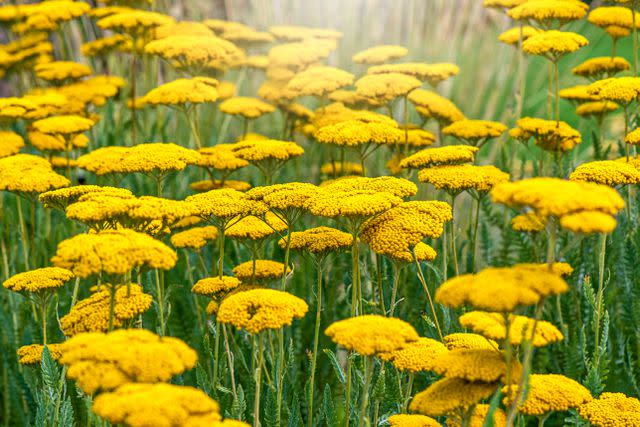
Jacky Parker Photography / GETTY IMAGES
Easy-care Achillea filipendulina produces long-lasting golden flowers from early spring to late fall. Textured silver-green leaves add to its appeal. "It takes you into autumn with some options for your tabletop," says Sanchez. This flower's fragrant blooms last a long time in a vase and can be dried into bright specimens for future arranging.
Zones: 3 to 9 (with some success in a wider range)
Planting time: Plant starts or early cuttings in spring after chance of frost has passed or early summer.
Size: 3 to 4 feet tall x 2 to 3 feet wide
Growing conditions: Full sun; almost any well-draining soil
Geum

Ingunn B. Haslekaas / GETTY IMAGES
A genus of the rose family, hardy Geum is available in a wide range of bloom colors. "To a lot of folks, they're going to look like a poppy, but they're much longer-lived flower than the poppies," Sanchez says. "And there are just so many to choose from."
Check before buying to make sure your pick is a late-season bloomer, she advises, and note that single-petaled flowers are better for pollinators than double-petaled ones, which obstruct access to food and are often sterile or of reduced nutritional benefit.
Zones: 4 to 9 (with a wider range for a few varieties; mulch some over winter in cold regions)
Planting time: Sow or divide and replant in spring after last frost date for your area or fall
Size: 6 to 36 inches tall x 6 to 24 inches wide
Growing conditions: Sun to part shade (provide afternoon shade in hotter regions); any fertile, moderately moist soil
Goldenrod (Fireworks)

Kinek00 / GETTY IMAGES
Solidago rugosa Fireworks pops with stunning yellow flowers along arching 18-inch stems. The top-rated plant in a goldenrod evaluation conducted by the Chicago Botanic Garden, it produces abundant blooms and fine-textured foliage, holds its shape while flowering, and resists pests and diseases well in the home garden.
It also spreads less quickly than many other goldenrods, staying under 5 feet. More good news: Goldenrod is not to blame for your fall allergies. "It just blooms at the same time as ragweed, which causes problems for a lot of people," Currey says.
Zones: 4 to 9
Planting time: Plant seeds or root divisions directly outdoors in after last frost date for your area in spring or fall or start indoors 6 to 8 weeks before last frost date
Size: 2 1/2 to 4 feet tall x 2 1/2 to 3 feet wide
Growing conditions: Full sun or partial shade, almost any well-draining soil
Goldenrod (Zigzag)

apugach / GETTY IMAGES
While most types of goldenrods like full sun, easy-care Solidago flexicaulis is native to North American woodlands and will tolerate even heavy shade (although sun-dappled part shade is its sweet spot). Its yellow flowers attract birds, bees, and butterflies, blooming well into fall on upright stems that sometimes grow in a zigzag shape. Like the Fireworks cultivar, it will spread, but not as aggressively as other goldenrod varieties.
Open and airy, goldenrod is lovely planted among other shade perennials, where it seems to float above ground-level plants. "It lightens the garden and provides some brightness at that mid-range height," says Currey.
Zones: 3 to 8
Planting time: Plant seeds or root divisions directly outdoors in fall or spring or start indoors 6 to 8 weeks before last frost date
Size: 1 to 3 feet tall x 1 to 3 feet wide
Growing conditions: Sun, part shade, shade; various soil types
Related: 11 Perennials to Plant in the Fall for Stunning Spring Blooms
Helenium
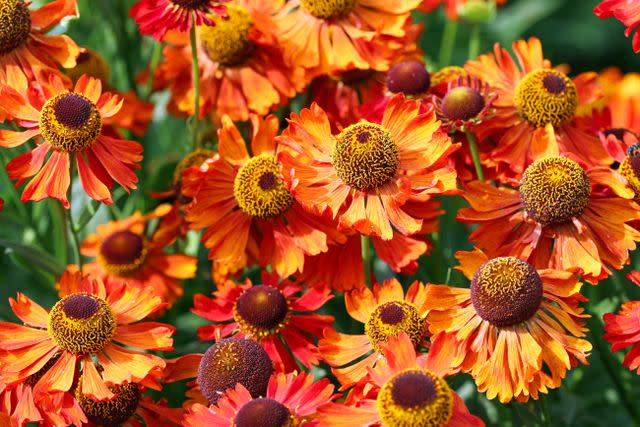
JohnatAPW / GETTY IMAGES
In its natural state, Helenium autumnale is more often than not found in wetland areas along streams and ponds and in ditches that dry out occasionally. That’s good news if you’re planting a rain garden or have clay soil that drains poorly.
Once it’s established versatile Helenium can also thrive in the high desert area she calls home. Also known as Sneezeweed and Helen’s Flower, it blooms from late summer through fall in shades of gold, orange, red, and copper-brown that are perfect for fall bouquets. "There are a quite a few varieties that change their shade as the flowers mature," Sanchez says. "So sometimes it looks like you have different colored flowers on the same plant."
Zones: 3 to 8
Planting time: Plant container-grown helenium any time between spring and fall. To plant from seed, start indoors 6 to 8 weeks before last frost date or propagate divisions or tip cuttings in early spring.
Size: 2 to 5 feet tall x 2 to 3 feet wide
Growing conditions: Full sun; medium to wet soil
Hyssop (Heatwave)
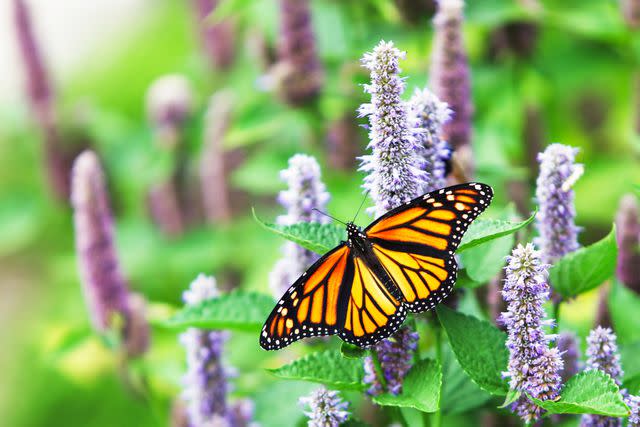
Willowpix / GETTY IMAGES
Native to the Midwest and Great Plains, Agastache foeniculum (also known as Anise Hyssop and Hummingbird Mint) blooms abundantly from mid to late summer into early fall, attracting bees, butterflies, and hummingbirds. Among Sanchez’s favorites: the Heatwave hybrids, which bloom in beautiful magenta to lavender-pink flowers that hold up through summer’s heat and keep the color coming into fall.
In a region where a nighttime frost can happen at almost any time, vase life matters. "One of the real benefits of this plant is its understated, licorice-tea fragrance when you bring it inside," she says.
Zones: 5 to 10
Planting time: Plant container plants last frost in spring through early summer or sow seeds directly into the garden in fall.
Size: 2 to 3 feet tall x 2 to 3 feet wide
Growing conditions: Full sun; fertile, sandy, well-draining soil
New England Aster

Angelika Antl / GETTY IMAGES
Symphyotrichum novae-angliae takes center stage in the fall garden, bursting with showy blooms in magenta, purple, and white. Their nectar offers and important food source for migrating monarch butterflies, and their profusion of small flowers works well to fill out fall bouquets, Sanchez says.
Zones: 4 to 8
Planting time: Propagate by division in spring or late fall
Size: 3 to 6 feet tall x 2 to 3 feet wide
Growing conditions: Full sun; moist, well-draining soil
Russian Sage

mtreasure / GETTY IMAGES
Salvia yangii, (formerly known as Perovskia atriplicifolia), blooms heartily until frost, and bees love it. This hardy perennial performs well even when conditions are dry, Sanchez says, and in addition to fragrant lavender-blue flowers, it has finely cut gray-green foliage that looks great with other colors and textures in the garden and bouquets.
Zones: 4 to 9
Planting time: Plant container plants in late spring or in fall, up to 6 weeks before first frost
Size: 3 to 8 feet tall x 2 to 3 feet wide
Growing conditions: Full sun; sandy, well-drained soil. Cover roots with mulch before winter or bury pots up to their rims to protect roots during the coldest months.
Salvia Mexicana (Limelight)
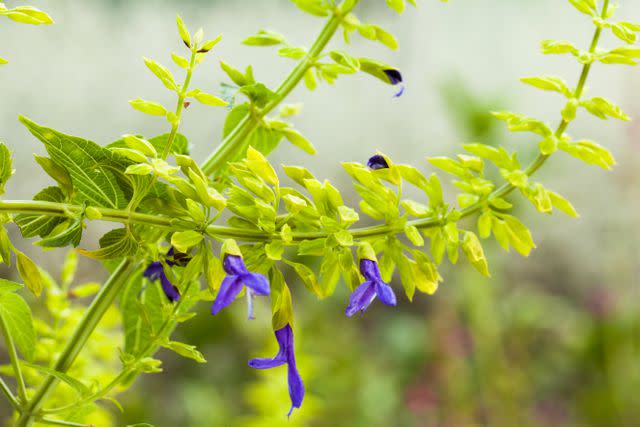
Lisa Romerein / GETTY IMAGES
Native to Mexico, this fall-blooming sage produces striking purple flowers in vibrant, lime green calyxes—the leaf-like whorls at the base of the flowers, which attract bees, butterflies, and hummingbirds. "Even after the flowers are gone, just the spike with the bright green calyx is pretty cool to include in an arrangement," Sanchez says.
Zones: 8 to 10
Planting time: Propagate in spring after chance of frost has passed or in summer. Can also be planted in fall in warm climates with mild winters.
Size: 3 to 8 feet tall x 4 to 6 feet wide
Growing conditions: Full sun; fertile, moist, well-draining soil
Sedum (Autumn Joy)
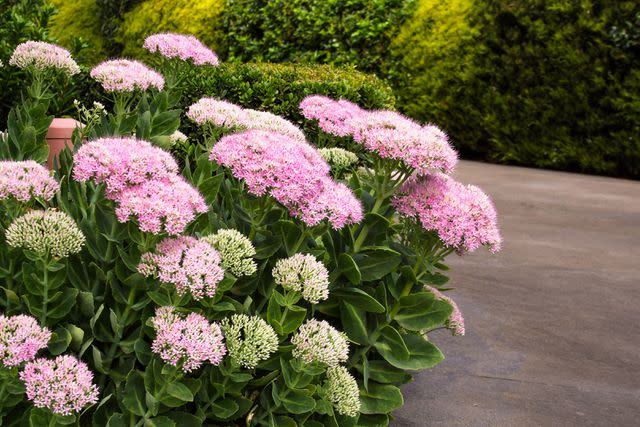
Andrew Waugh / GETTY IMAGES
Sanchez loves the resilience and colors of "old school" Hylotelephium telephiu. A reliable bloomer from late summer through fall, it produces domes of tiny raspberry-pink blossoms that evolve to bronze rose and then copper-rust as the season progresses. It’s also pollinator-friendly, drought and heat tolerant, and disease resistant.
Zones: 3 to 9
Planting time: Propagate with stem cuttings or plant division in early summer.
Size: 1 1/2 to 2 feet tall x 1 1/2 to 2 feet wide
Growing conditions: Full sun; sandy, well-draining soil
Smooth Aster (October Skies)
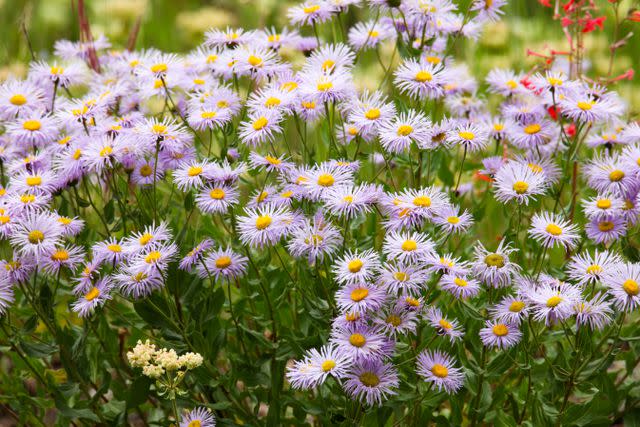
Brian Brown / GETTY IMAGES
Bushy North America native Symphyotrichum laeve blooms throughout the fall season and even well into November in some regions, offering a continuous display of aromatic blue-lavender blooms with yellow centers that evolve to a toasty gold.
"It’s just super floriferous," Currey says. "There will be literally hundreds of blooms covering each plant, just mounds of color. And pollinators love it, so it’s really good for late season pollinator support." A bit shorter than other asters, it also maintains its shape well.
Zones: 3 to 8
Planting time: Divide and replant in spring as soon as new growth appears.
Size: 18 to 24 inches tall x 20 to 24 inches wide
Growing conditions: Full sun; almost any well-drained soil
Variegated Miscanthus
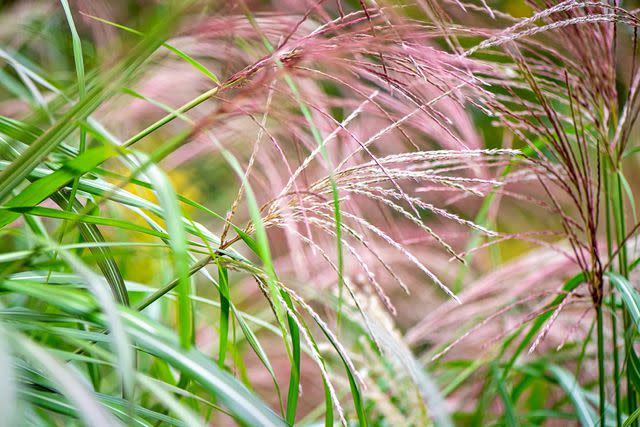
Jacky Parker Photography / GETTY IMAGES
Miscanthus sinensis 'Variegatus' has beautiful striped leaves and produces feathery flower plumes in purple, red, orange, or gold late summer and early fall. "We often don't think about them as flowers, but they really are," Sanchez says, adding that grasses are easy to care for and come in a variety of sizes, making it easy to find one that suits your space.
Warning: While newer, noninvasive varieties of miscanthus are available, some on the market are invasive. Miscanthus can also create a fire hazard in dry regions. Check with your extension office to learn which options are best for your area.
Zones: 4 to 9
Planting time: Plant container-grown plants in spring after chance of frost has passed.
Size: 3 to 12 feet tall x 2 to 6 feet wide
Growing conditions: Full sun to partial shade (but more sun creates better blooms); fertile, moist, well-draining soil
Related: Your Complete Guide to Fall Gardening, From Prep to Planting
Read the original article on Martha Stewart.

